Research Methodology
VerifiedAdded on 2023/03/23
|10
|2565
|49
AI Summary
This document discusses the research methodology used to investigate factors influencing the risk of giving out a loan by micro-credit firms and how these institutions are managing these risks from their customers. It covers the research design, data collection methods, sample selection, ethical considerations, and data analysis techniques.
Contribute Materials
Your contribution can guide someone’s learning journey. Share your
documents today.

Research Methodology
Student’s Name:
Institution:
Student’s Name:
Institution:
Secure Best Marks with AI Grader
Need help grading? Try our AI Grader for instant feedback on your assignments.
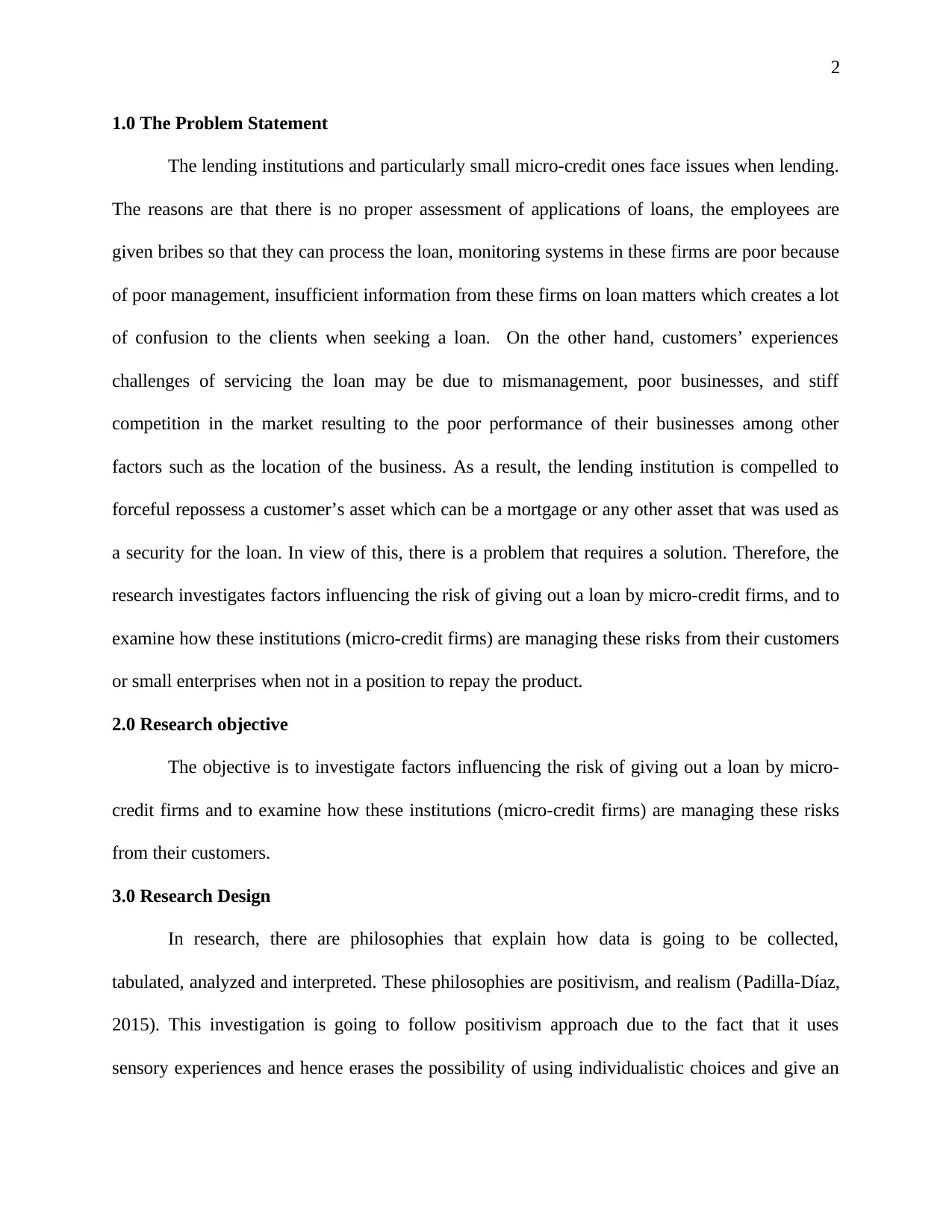
2
1.0 The Problem Statement
The lending institutions and particularly small micro-credit ones face issues when lending.
The reasons are that there is no proper assessment of applications of loans, the employees are
given bribes so that they can process the loan, monitoring systems in these firms are poor because
of poor management, insufficient information from these firms on loan matters which creates a lot
of confusion to the clients when seeking a loan. On the other hand, customers’ experiences
challenges of servicing the loan may be due to mismanagement, poor businesses, and stiff
competition in the market resulting to the poor performance of their businesses among other
factors such as the location of the business. As a result, the lending institution is compelled to
forceful repossess a customer’s asset which can be a mortgage or any other asset that was used as
a security for the loan. In view of this, there is a problem that requires a solution. Therefore, the
research investigates factors influencing the risk of giving out a loan by micro-credit firms, and to
examine how these institutions (micro-credit firms) are managing these risks from their customers
or small enterprises when not in a position to repay the product.
2.0 Research objective
The objective is to investigate factors influencing the risk of giving out a loan by micro-
credit firms and to examine how these institutions (micro-credit firms) are managing these risks
from their customers.
3.0 Research Design
In research, there are philosophies that explain how data is going to be collected,
tabulated, analyzed and interpreted. These philosophies are positivism, and realism (Padilla-Díaz,
2015). This investigation is going to follow positivism approach due to the fact that it uses
sensory experiences and hence erases the possibility of using individualistic choices and give an
1.0 The Problem Statement
The lending institutions and particularly small micro-credit ones face issues when lending.
The reasons are that there is no proper assessment of applications of loans, the employees are
given bribes so that they can process the loan, monitoring systems in these firms are poor because
of poor management, insufficient information from these firms on loan matters which creates a lot
of confusion to the clients when seeking a loan. On the other hand, customers’ experiences
challenges of servicing the loan may be due to mismanagement, poor businesses, and stiff
competition in the market resulting to the poor performance of their businesses among other
factors such as the location of the business. As a result, the lending institution is compelled to
forceful repossess a customer’s asset which can be a mortgage or any other asset that was used as
a security for the loan. In view of this, there is a problem that requires a solution. Therefore, the
research investigates factors influencing the risk of giving out a loan by micro-credit firms, and to
examine how these institutions (micro-credit firms) are managing these risks from their customers
or small enterprises when not in a position to repay the product.
2.0 Research objective
The objective is to investigate factors influencing the risk of giving out a loan by micro-
credit firms and to examine how these institutions (micro-credit firms) are managing these risks
from their customers.
3.0 Research Design
In research, there are philosophies that explain how data is going to be collected,
tabulated, analyzed and interpreted. These philosophies are positivism, and realism (Padilla-Díaz,
2015). This investigation is going to follow positivism approach due to the fact that it uses
sensory experiences and hence erases the possibility of using individualistic choices and give an
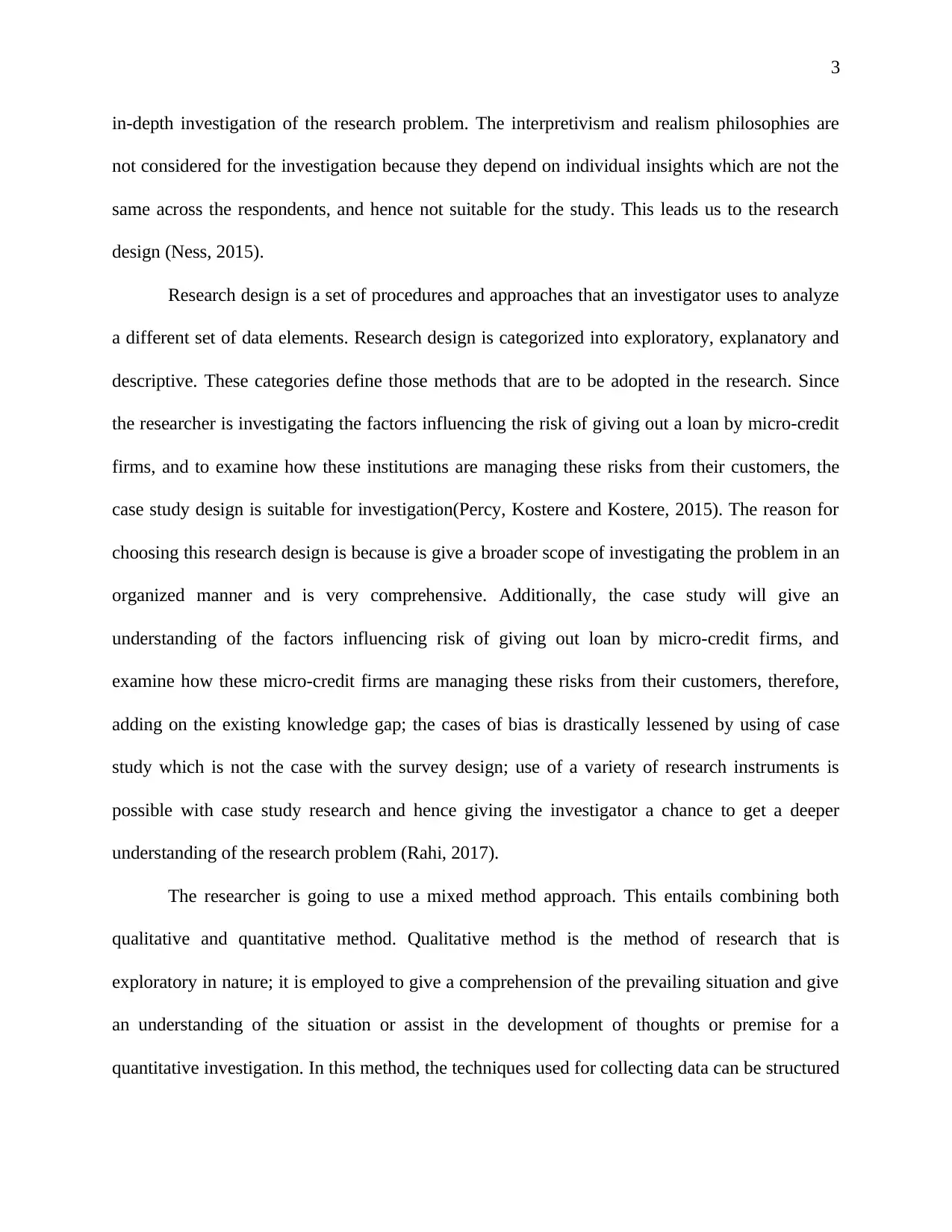
3
in-depth investigation of the research problem. The interpretivism and realism philosophies are
not considered for the investigation because they depend on individual insights which are not the
same across the respondents, and hence not suitable for the study. This leads us to the research
design (Ness, 2015).
Research design is a set of procedures and approaches that an investigator uses to analyze
a different set of data elements. Research design is categorized into exploratory, explanatory and
descriptive. These categories define those methods that are to be adopted in the research. Since
the researcher is investigating the factors influencing the risk of giving out a loan by micro-credit
firms, and to examine how these institutions are managing these risks from their customers, the
case study design is suitable for investigation(Percy, Kostere and Kostere, 2015). The reason for
choosing this research design is because is give a broader scope of investigating the problem in an
organized manner and is very comprehensive. Additionally, the case study will give an
understanding of the factors influencing risk of giving out loan by micro-credit firms, and
examine how these micro-credit firms are managing these risks from their customers, therefore,
adding on the existing knowledge gap; the cases of bias is drastically lessened by using of case
study which is not the case with the survey design; use of a variety of research instruments is
possible with case study research and hence giving the investigator a chance to get a deeper
understanding of the research problem (Rahi, 2017).
The researcher is going to use a mixed method approach. This entails combining both
qualitative and quantitative method. Qualitative method is the method of research that is
exploratory in nature; it is employed to give a comprehension of the prevailing situation and give
an understanding of the situation or assist in the development of thoughts or premise for a
quantitative investigation. In this method, the techniques used for collecting data can be structured
in-depth investigation of the research problem. The interpretivism and realism philosophies are
not considered for the investigation because they depend on individual insights which are not the
same across the respondents, and hence not suitable for the study. This leads us to the research
design (Ness, 2015).
Research design is a set of procedures and approaches that an investigator uses to analyze
a different set of data elements. Research design is categorized into exploratory, explanatory and
descriptive. These categories define those methods that are to be adopted in the research. Since
the researcher is investigating the factors influencing the risk of giving out a loan by micro-credit
firms, and to examine how these institutions are managing these risks from their customers, the
case study design is suitable for investigation(Percy, Kostere and Kostere, 2015). The reason for
choosing this research design is because is give a broader scope of investigating the problem in an
organized manner and is very comprehensive. Additionally, the case study will give an
understanding of the factors influencing risk of giving out loan by micro-credit firms, and
examine how these micro-credit firms are managing these risks from their customers, therefore,
adding on the existing knowledge gap; the cases of bias is drastically lessened by using of case
study which is not the case with the survey design; use of a variety of research instruments is
possible with case study research and hence giving the investigator a chance to get a deeper
understanding of the research problem (Rahi, 2017).
The researcher is going to use a mixed method approach. This entails combining both
qualitative and quantitative method. Qualitative method is the method of research that is
exploratory in nature; it is employed to give a comprehension of the prevailing situation and give
an understanding of the situation or assist in the development of thoughts or premise for a
quantitative investigation. In this method, the techniques used for collecting data can be structured
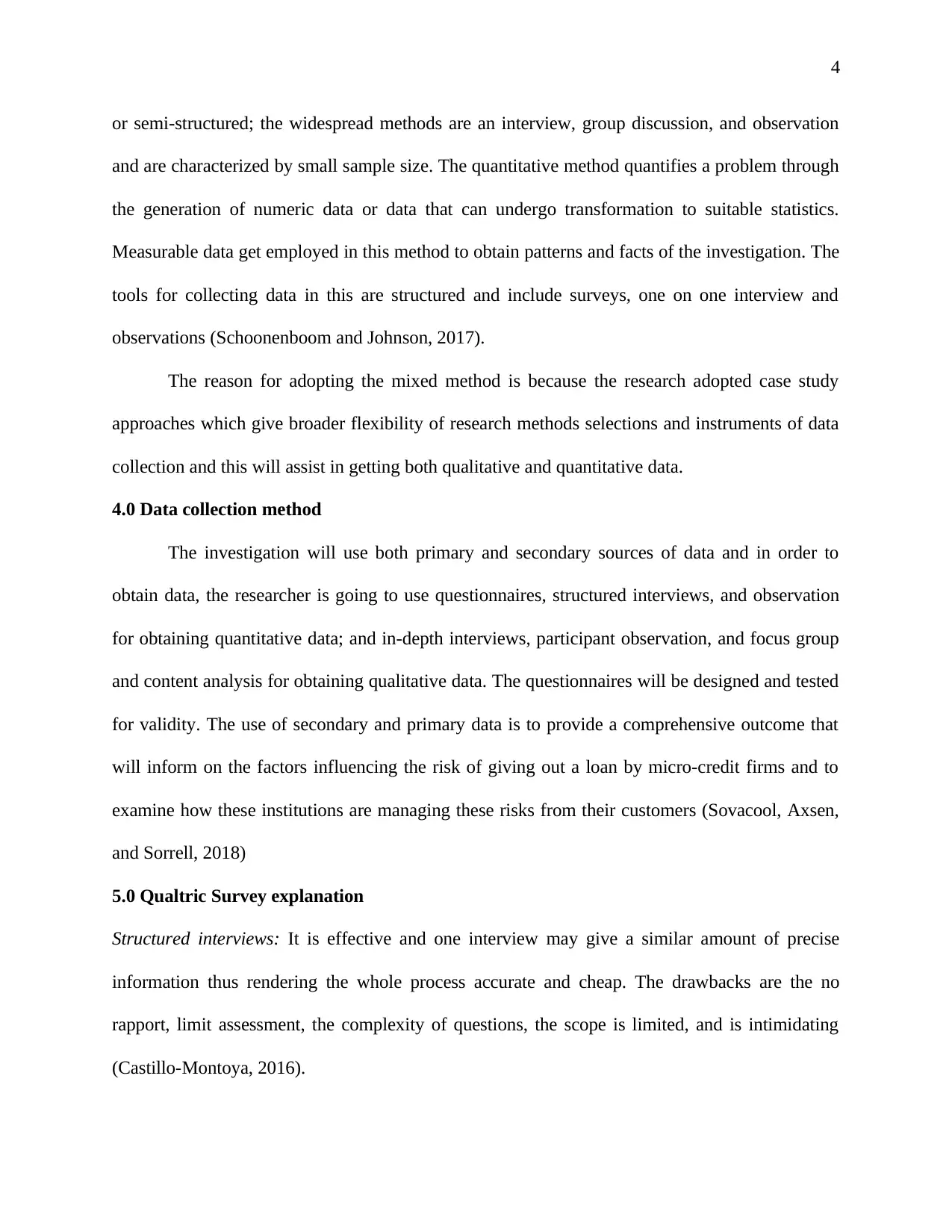
4
or semi-structured; the widespread methods are an interview, group discussion, and observation
and are characterized by small sample size. The quantitative method quantifies a problem through
the generation of numeric data or data that can undergo transformation to suitable statistics.
Measurable data get employed in this method to obtain patterns and facts of the investigation. The
tools for collecting data in this are structured and include surveys, one on one interview and
observations (Schoonenboom and Johnson, 2017).
The reason for adopting the mixed method is because the research adopted case study
approaches which give broader flexibility of research methods selections and instruments of data
collection and this will assist in getting both qualitative and quantitative data.
4.0 Data collection method
The investigation will use both primary and secondary sources of data and in order to
obtain data, the researcher is going to use questionnaires, structured interviews, and observation
for obtaining quantitative data; and in-depth interviews, participant observation, and focus group
and content analysis for obtaining qualitative data. The questionnaires will be designed and tested
for validity. The use of secondary and primary data is to provide a comprehensive outcome that
will inform on the factors influencing the risk of giving out a loan by micro-credit firms and to
examine how these institutions are managing these risks from their customers (Sovacool, Axsen,
and Sorrell, 2018)
5.0 Qualtric Survey explanation
Structured interviews: It is effective and one interview may give a similar amount of precise
information thus rendering the whole process accurate and cheap. The drawbacks are the no
rapport, limit assessment, the complexity of questions, the scope is limited, and is intimidating
(Castillo-Montoya, 2016).
or semi-structured; the widespread methods are an interview, group discussion, and observation
and are characterized by small sample size. The quantitative method quantifies a problem through
the generation of numeric data or data that can undergo transformation to suitable statistics.
Measurable data get employed in this method to obtain patterns and facts of the investigation. The
tools for collecting data in this are structured and include surveys, one on one interview and
observations (Schoonenboom and Johnson, 2017).
The reason for adopting the mixed method is because the research adopted case study
approaches which give broader flexibility of research methods selections and instruments of data
collection and this will assist in getting both qualitative and quantitative data.
4.0 Data collection method
The investigation will use both primary and secondary sources of data and in order to
obtain data, the researcher is going to use questionnaires, structured interviews, and observation
for obtaining quantitative data; and in-depth interviews, participant observation, and focus group
and content analysis for obtaining qualitative data. The questionnaires will be designed and tested
for validity. The use of secondary and primary data is to provide a comprehensive outcome that
will inform on the factors influencing the risk of giving out a loan by micro-credit firms and to
examine how these institutions are managing these risks from their customers (Sovacool, Axsen,
and Sorrell, 2018)
5.0 Qualtric Survey explanation
Structured interviews: It is effective and one interview may give a similar amount of precise
information thus rendering the whole process accurate and cheap. The drawbacks are the no
rapport, limit assessment, the complexity of questions, the scope is limited, and is intimidating
(Castillo-Montoya, 2016).
Secure Best Marks with AI Grader
Need help grading? Try our AI Grader for instant feedback on your assignments.
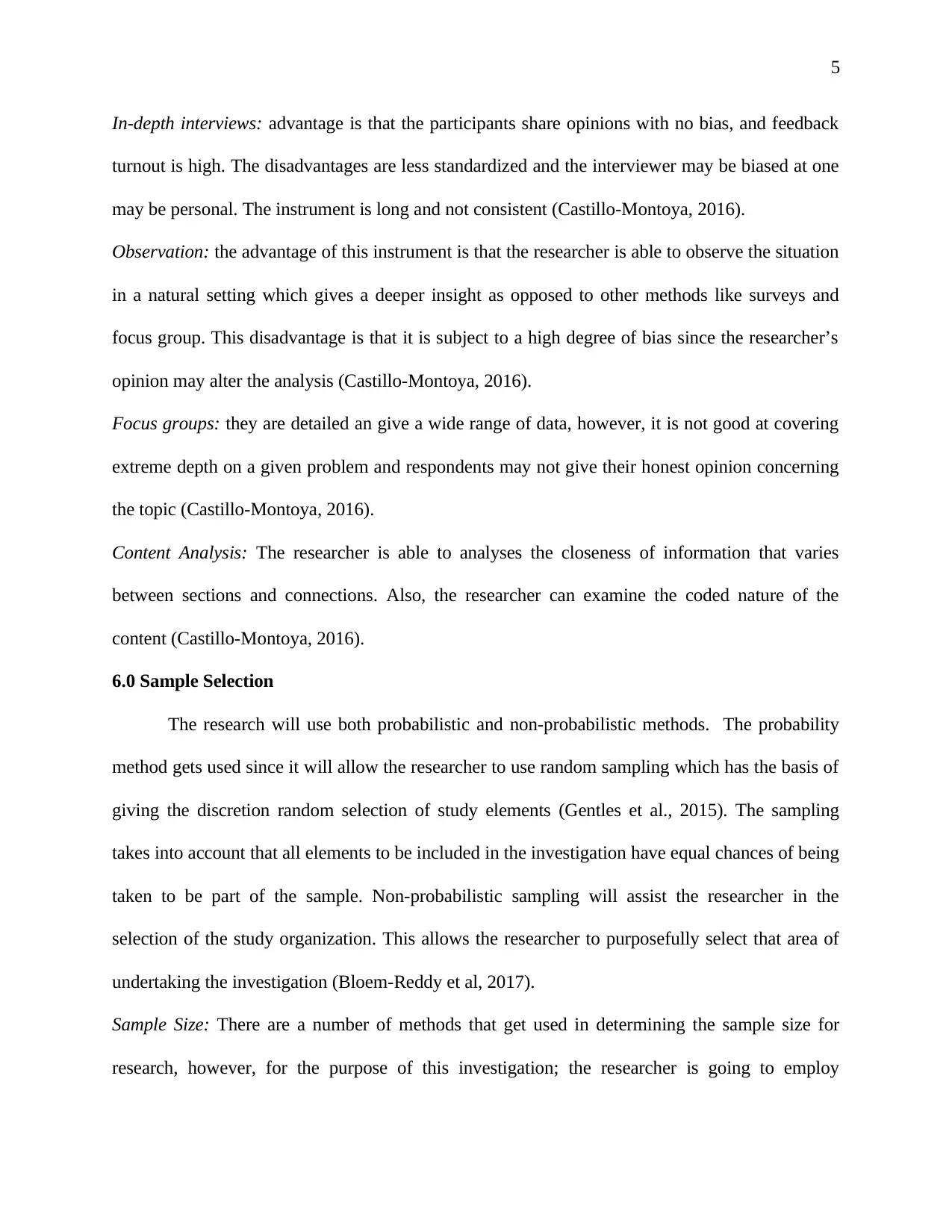
5
In-depth interviews: advantage is that the participants share opinions with no bias, and feedback
turnout is high. The disadvantages are less standardized and the interviewer may be biased at one
may be personal. The instrument is long and not consistent (Castillo-Montoya, 2016).
Observation: the advantage of this instrument is that the researcher is able to observe the situation
in a natural setting which gives a deeper insight as opposed to other methods like surveys and
focus group. This disadvantage is that it is subject to a high degree of bias since the researcher’s
opinion may alter the analysis (Castillo-Montoya, 2016).
Focus groups: they are detailed an give a wide range of data, however, it is not good at covering
extreme depth on a given problem and respondents may not give their honest opinion concerning
the topic (Castillo-Montoya, 2016).
Content Analysis: The researcher is able to analyses the closeness of information that varies
between sections and connections. Also, the researcher can examine the coded nature of the
content (Castillo-Montoya, 2016).
6.0 Sample Selection
The research will use both probabilistic and non-probabilistic methods. The probability
method gets used since it will allow the researcher to use random sampling which has the basis of
giving the discretion random selection of study elements (Gentles et al., 2015). The sampling
takes into account that all elements to be included in the investigation have equal chances of being
taken to be part of the sample. Non-probabilistic sampling will assist the researcher in the
selection of the study organization. This allows the researcher to purposefully select that area of
undertaking the investigation (Bloem-Reddy et al, 2017).
Sample Size: There are a number of methods that get used in determining the sample size for
research, however, for the purpose of this investigation; the researcher is going to employ
In-depth interviews: advantage is that the participants share opinions with no bias, and feedback
turnout is high. The disadvantages are less standardized and the interviewer may be biased at one
may be personal. The instrument is long and not consistent (Castillo-Montoya, 2016).
Observation: the advantage of this instrument is that the researcher is able to observe the situation
in a natural setting which gives a deeper insight as opposed to other methods like surveys and
focus group. This disadvantage is that it is subject to a high degree of bias since the researcher’s
opinion may alter the analysis (Castillo-Montoya, 2016).
Focus groups: they are detailed an give a wide range of data, however, it is not good at covering
extreme depth on a given problem and respondents may not give their honest opinion concerning
the topic (Castillo-Montoya, 2016).
Content Analysis: The researcher is able to analyses the closeness of information that varies
between sections and connections. Also, the researcher can examine the coded nature of the
content (Castillo-Montoya, 2016).
6.0 Sample Selection
The research will use both probabilistic and non-probabilistic methods. The probability
method gets used since it will allow the researcher to use random sampling which has the basis of
giving the discretion random selection of study elements (Gentles et al., 2015). The sampling
takes into account that all elements to be included in the investigation have equal chances of being
taken to be part of the sample. Non-probabilistic sampling will assist the researcher in the
selection of the study organization. This allows the researcher to purposefully select that area of
undertaking the investigation (Bloem-Reddy et al, 2017).
Sample Size: There are a number of methods that get used in determining the sample size for
research, however, for the purpose of this investigation; the researcher is going to employ
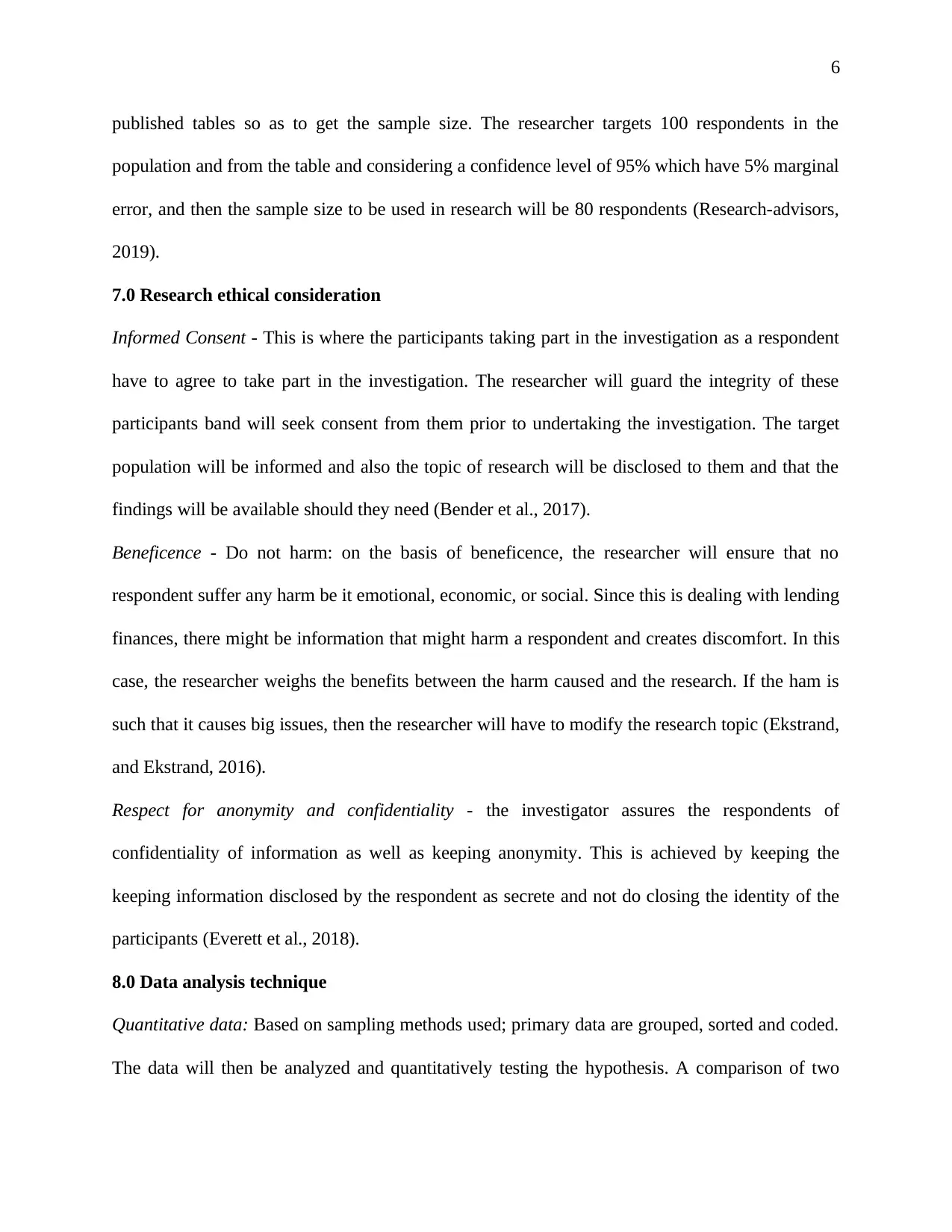
6
published tables so as to get the sample size. The researcher targets 100 respondents in the
population and from the table and considering a confidence level of 95% which have 5% marginal
error, and then the sample size to be used in research will be 80 respondents (Research-advisors,
2019).
7.0 Research ethical consideration
Informed Consent - This is where the participants taking part in the investigation as a respondent
have to agree to take part in the investigation. The researcher will guard the integrity of these
participants band will seek consent from them prior to undertaking the investigation. The target
population will be informed and also the topic of research will be disclosed to them and that the
findings will be available should they need (Bender et al., 2017).
Beneficence - Do not harm: on the basis of beneficence, the researcher will ensure that no
respondent suffer any harm be it emotional, economic, or social. Since this is dealing with lending
finances, there might be information that might harm a respondent and creates discomfort. In this
case, the researcher weighs the benefits between the harm caused and the research. If the ham is
such that it causes big issues, then the researcher will have to modify the research topic (Ekstrand,
and Ekstrand, 2016).
Respect for anonymity and confidentiality - the investigator assures the respondents of
confidentiality of information as well as keeping anonymity. This is achieved by keeping the
keeping information disclosed by the respondent as secrete and not do closing the identity of the
participants (Everett et al., 2018).
8.0 Data analysis technique
Quantitative data: Based on sampling methods used; primary data are grouped, sorted and coded.
The data will then be analyzed and quantitatively testing the hypothesis. A comparison of two
published tables so as to get the sample size. The researcher targets 100 respondents in the
population and from the table and considering a confidence level of 95% which have 5% marginal
error, and then the sample size to be used in research will be 80 respondents (Research-advisors,
2019).
7.0 Research ethical consideration
Informed Consent - This is where the participants taking part in the investigation as a respondent
have to agree to take part in the investigation. The researcher will guard the integrity of these
participants band will seek consent from them prior to undertaking the investigation. The target
population will be informed and also the topic of research will be disclosed to them and that the
findings will be available should they need (Bender et al., 2017).
Beneficence - Do not harm: on the basis of beneficence, the researcher will ensure that no
respondent suffer any harm be it emotional, economic, or social. Since this is dealing with lending
finances, there might be information that might harm a respondent and creates discomfort. In this
case, the researcher weighs the benefits between the harm caused and the research. If the ham is
such that it causes big issues, then the researcher will have to modify the research topic (Ekstrand,
and Ekstrand, 2016).
Respect for anonymity and confidentiality - the investigator assures the respondents of
confidentiality of information as well as keeping anonymity. This is achieved by keeping the
keeping information disclosed by the respondent as secrete and not do closing the identity of the
participants (Everett et al., 2018).
8.0 Data analysis technique
Quantitative data: Based on sampling methods used; primary data are grouped, sorted and coded.
The data will then be analyzed and quantitatively testing the hypothesis. A comparison of two
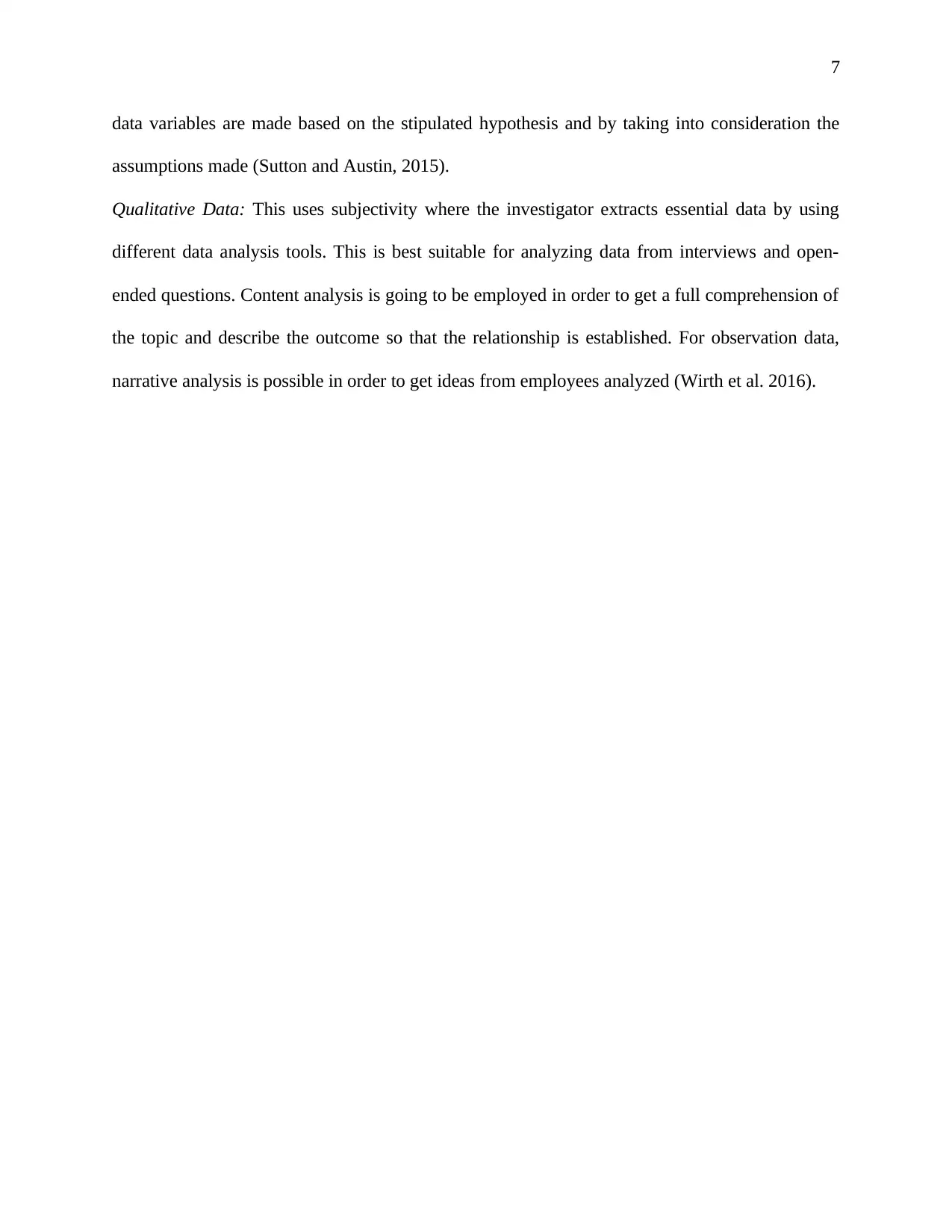
7
data variables are made based on the stipulated hypothesis and by taking into consideration the
assumptions made (Sutton and Austin, 2015).
Qualitative Data: This uses subjectivity where the investigator extracts essential data by using
different data analysis tools. This is best suitable for analyzing data from interviews and open-
ended questions. Content analysis is going to be employed in order to get a full comprehension of
the topic and describe the outcome so that the relationship is established. For observation data,
narrative analysis is possible in order to get ideas from employees analyzed (Wirth et al. 2016).
data variables are made based on the stipulated hypothesis and by taking into consideration the
assumptions made (Sutton and Austin, 2015).
Qualitative Data: This uses subjectivity where the investigator extracts essential data by using
different data analysis tools. This is best suitable for analyzing data from interviews and open-
ended questions. Content analysis is going to be employed in order to get a full comprehension of
the topic and describe the outcome so that the relationship is established. For observation data,
narrative analysis is possible in order to get ideas from employees analyzed (Wirth et al. 2016).
Paraphrase This Document
Need a fresh take? Get an instant paraphrase of this document with our AI Paraphraser
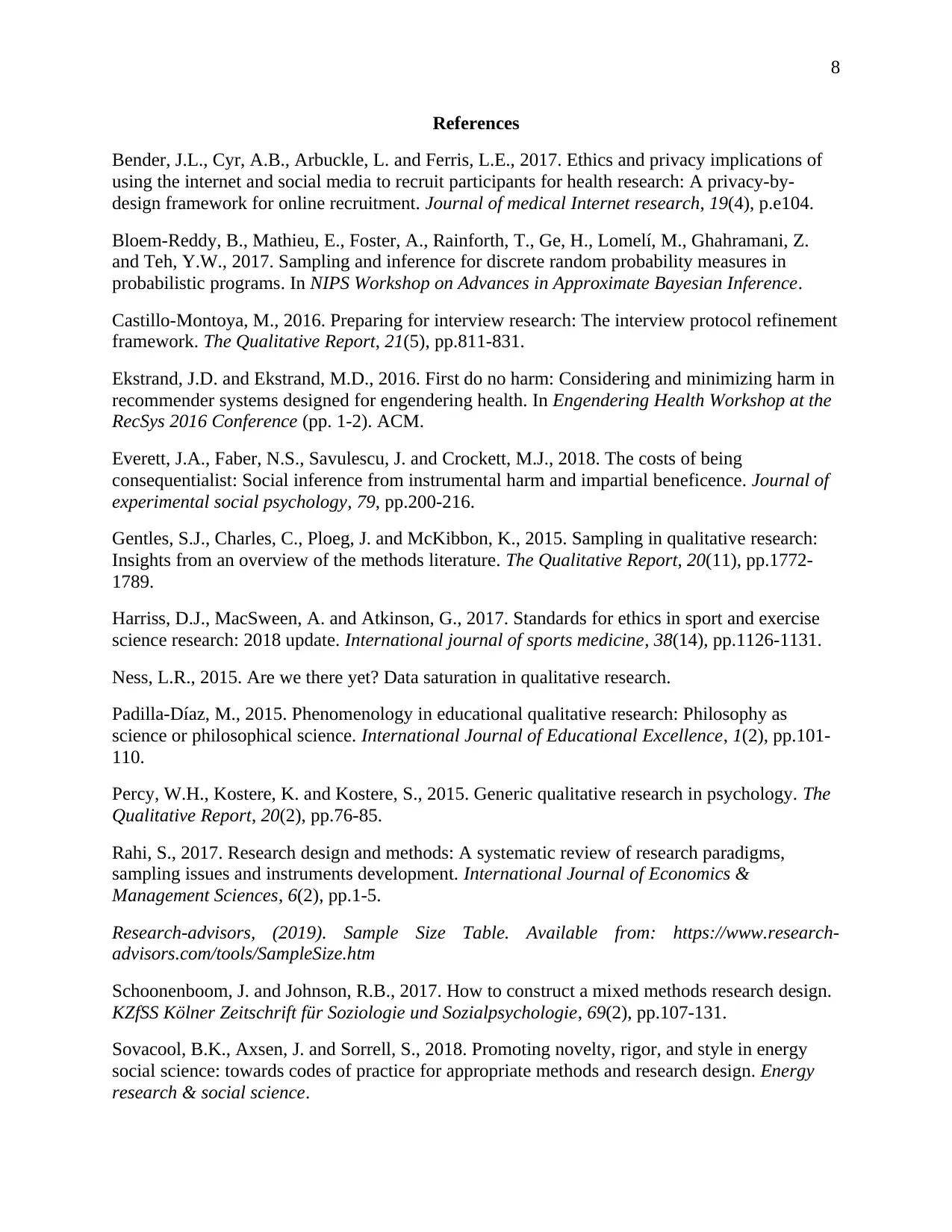
8
References
Bender, J.L., Cyr, A.B., Arbuckle, L. and Ferris, L.E., 2017. Ethics and privacy implications of
using the internet and social media to recruit participants for health research: A privacy-by-
design framework for online recruitment. Journal of medical Internet research, 19(4), p.e104.
Bloem-Reddy, B., Mathieu, E., Foster, A., Rainforth, T., Ge, H., Lomelí, M., Ghahramani, Z.
and Teh, Y.W., 2017. Sampling and inference for discrete random probability measures in
probabilistic programs. In NIPS Workshop on Advances in Approximate Bayesian Inference.
Castillo-Montoya, M., 2016. Preparing for interview research: The interview protocol refinement
framework. The Qualitative Report, 21(5), pp.811-831.
Ekstrand, J.D. and Ekstrand, M.D., 2016. First do no harm: Considering and minimizing harm in
recommender systems designed for engendering health. In Engendering Health Workshop at the
RecSys 2016 Conference (pp. 1-2). ACM.
Everett, J.A., Faber, N.S., Savulescu, J. and Crockett, M.J., 2018. The costs of being
consequentialist: Social inference from instrumental harm and impartial beneficence. Journal of
experimental social psychology, 79, pp.200-216.
Gentles, S.J., Charles, C., Ploeg, J. and McKibbon, K., 2015. Sampling in qualitative research:
Insights from an overview of the methods literature. The Qualitative Report, 20(11), pp.1772-
1789.
Harriss, D.J., MacSween, A. and Atkinson, G., 2017. Standards for ethics in sport and exercise
science research: 2018 update. International journal of sports medicine, 38(14), pp.1126-1131.
Ness, L.R., 2015. Are we there yet? Data saturation in qualitative research.
Padilla-Díaz, M., 2015. Phenomenology in educational qualitative research: Philosophy as
science or philosophical science. International Journal of Educational Excellence, 1(2), pp.101-
110.
Percy, W.H., Kostere, K. and Kostere, S., 2015. Generic qualitative research in psychology. The
Qualitative Report, 20(2), pp.76-85.
Rahi, S., 2017. Research design and methods: A systematic review of research paradigms,
sampling issues and instruments development. International Journal of Economics &
Management Sciences, 6(2), pp.1-5.
Research-advisors, (2019). Sample Size Table. Available from: https://www.research-
advisors.com/tools/SampleSize.htm
Schoonenboom, J. and Johnson, R.B., 2017. How to construct a mixed methods research design.
KZfSS Kölner Zeitschrift für Soziologie und Sozialpsychologie, 69(2), pp.107-131.
Sovacool, B.K., Axsen, J. and Sorrell, S., 2018. Promoting novelty, rigor, and style in energy
social science: towards codes of practice for appropriate methods and research design. Energy
research & social science.
References
Bender, J.L., Cyr, A.B., Arbuckle, L. and Ferris, L.E., 2017. Ethics and privacy implications of
using the internet and social media to recruit participants for health research: A privacy-by-
design framework for online recruitment. Journal of medical Internet research, 19(4), p.e104.
Bloem-Reddy, B., Mathieu, E., Foster, A., Rainforth, T., Ge, H., Lomelí, M., Ghahramani, Z.
and Teh, Y.W., 2017. Sampling and inference for discrete random probability measures in
probabilistic programs. In NIPS Workshop on Advances in Approximate Bayesian Inference.
Castillo-Montoya, M., 2016. Preparing for interview research: The interview protocol refinement
framework. The Qualitative Report, 21(5), pp.811-831.
Ekstrand, J.D. and Ekstrand, M.D., 2016. First do no harm: Considering and minimizing harm in
recommender systems designed for engendering health. In Engendering Health Workshop at the
RecSys 2016 Conference (pp. 1-2). ACM.
Everett, J.A., Faber, N.S., Savulescu, J. and Crockett, M.J., 2018. The costs of being
consequentialist: Social inference from instrumental harm and impartial beneficence. Journal of
experimental social psychology, 79, pp.200-216.
Gentles, S.J., Charles, C., Ploeg, J. and McKibbon, K., 2015. Sampling in qualitative research:
Insights from an overview of the methods literature. The Qualitative Report, 20(11), pp.1772-
1789.
Harriss, D.J., MacSween, A. and Atkinson, G., 2017. Standards for ethics in sport and exercise
science research: 2018 update. International journal of sports medicine, 38(14), pp.1126-1131.
Ness, L.R., 2015. Are we there yet? Data saturation in qualitative research.
Padilla-Díaz, M., 2015. Phenomenology in educational qualitative research: Philosophy as
science or philosophical science. International Journal of Educational Excellence, 1(2), pp.101-
110.
Percy, W.H., Kostere, K. and Kostere, S., 2015. Generic qualitative research in psychology. The
Qualitative Report, 20(2), pp.76-85.
Rahi, S., 2017. Research design and methods: A systematic review of research paradigms,
sampling issues and instruments development. International Journal of Economics &
Management Sciences, 6(2), pp.1-5.
Research-advisors, (2019). Sample Size Table. Available from: https://www.research-
advisors.com/tools/SampleSize.htm
Schoonenboom, J. and Johnson, R.B., 2017. How to construct a mixed methods research design.
KZfSS Kölner Zeitschrift für Soziologie und Sozialpsychologie, 69(2), pp.107-131.
Sovacool, B.K., Axsen, J. and Sorrell, S., 2018. Promoting novelty, rigor, and style in energy
social science: towards codes of practice for appropriate methods and research design. Energy
research & social science.
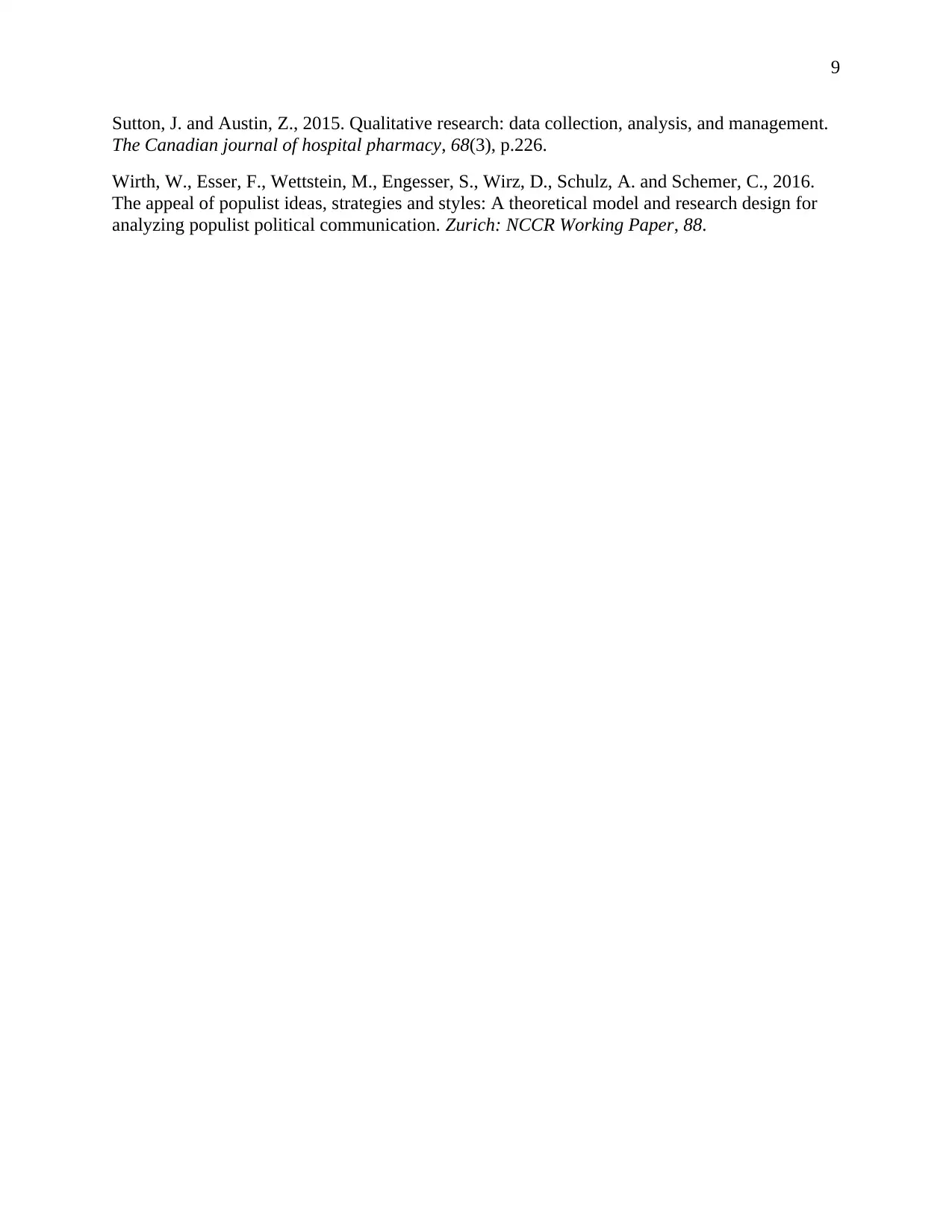
9
Sutton, J. and Austin, Z., 2015. Qualitative research: data collection, analysis, and management.
The Canadian journal of hospital pharmacy, 68(3), p.226.
Wirth, W., Esser, F., Wettstein, M., Engesser, S., Wirz, D., Schulz, A. and Schemer, C., 2016.
The appeal of populist ideas, strategies and styles: A theoretical model and research design for
analyzing populist political communication. Zurich: NCCR Working Paper, 88.
Sutton, J. and Austin, Z., 2015. Qualitative research: data collection, analysis, and management.
The Canadian journal of hospital pharmacy, 68(3), p.226.
Wirth, W., Esser, F., Wettstein, M., Engesser, S., Wirz, D., Schulz, A. and Schemer, C., 2016.
The appeal of populist ideas, strategies and styles: A theoretical model and research design for
analyzing populist political communication. Zurich: NCCR Working Paper, 88.
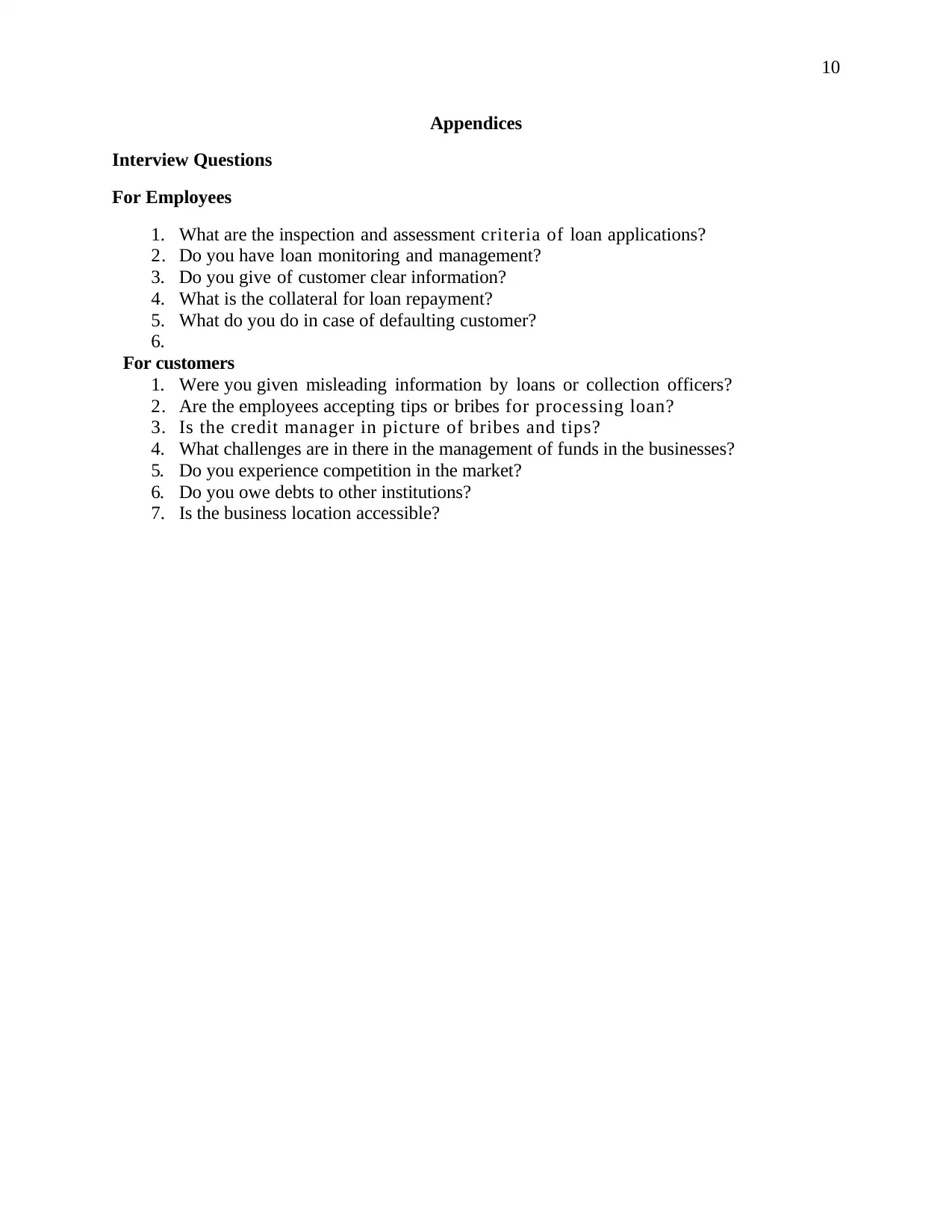
10
Appendices
Interview Questions
For Employees
1. What are the inspection and assessment criteria of loan applications?
2. Do you have loan monitoring and management?
3. Do you give of customer clear information?
4. What is the collateral for loan repayment?
5. What do you do in case of defaulting customer?
6.
For customers
1. Were you given misleading information by loans or collection officers?
2. Are the employees accepting tips or bribes for processing loan?
3. Is the credit manager in picture of bribes and tips?
4. What challenges are in there in the management of funds in the businesses?
5. Do you experience competition in the market?
6. Do you owe debts to other institutions?
7. Is the business location accessible?
Appendices
Interview Questions
For Employees
1. What are the inspection and assessment criteria of loan applications?
2. Do you have loan monitoring and management?
3. Do you give of customer clear information?
4. What is the collateral for loan repayment?
5. What do you do in case of defaulting customer?
6.
For customers
1. Were you given misleading information by loans or collection officers?
2. Are the employees accepting tips or bribes for processing loan?
3. Is the credit manager in picture of bribes and tips?
4. What challenges are in there in the management of funds in the businesses?
5. Do you experience competition in the market?
6. Do you owe debts to other institutions?
7. Is the business location accessible?
1 out of 10
Related Documents
Your All-in-One AI-Powered Toolkit for Academic Success.
+13062052269
info@desklib.com
Available 24*7 on WhatsApp / Email
![[object Object]](/_next/static/media/star-bottom.7253800d.svg)
Unlock your academic potential
© 2024 | Zucol Services PVT LTD | All rights reserved.





